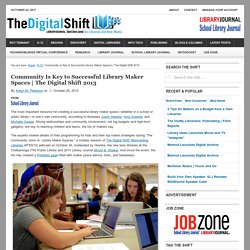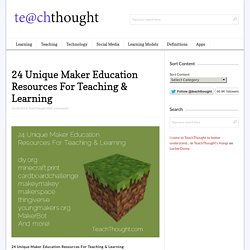

Community Is Key to Successful Library Maker Spaces. The most important resource for creating a successful library maker space—whether in a school or public library—is one’s own community, according to librarians Justin Hoenke, Amy Koester, and Michelle Cooper.

Strong relationships and community involvement, not big budgets and high-tech gadgetry, are key to reaching children and teens, the trio of makers say. The experts shared details of their programming for kids and their top maker strategies during “The Community Joins In: Library Maker Spaces,” a midday session of The Digital Shift: Reinventing Libraries (#TDS13) webcast on October 16, moderated by Hoenke, the new teen librarian at the Chattanooga (TN) Public Library and 2013 Library Journal Mover & Shaker. And since the event, the trio has created a Pinterest page filled with maker space advice, links, and takeaways.
Kids learn to code at Chattanooga Public Library’s DevDev summer code camp, 2013. Cooper, school librarian at Henderson (TX) High School, also recommends this approach. 24 Unique Maker Education Resources For Teaching & Learning. 24 Unique Maker Education Resources For Teaching & Learning by Mike Acedo 1.

Makezine.com is a major hub for the maker’s movement, providing amateur makers and educators with a plethora of information, resources, and project ideas to implement for themselves, or in their classrooms. 2. This UK based tech company seeks to provide children of all ages and backgrounds with cheap, quality computers in hopes of educating kids in computer programming. 3. The Maker Faire is an annual festival that takes place in multiple locations around the world, bringing together inventors, scientists, engineers, educators, tech enthusiasts, among other makers, to showcase innovation, learning, and celebrate the maker’s movement. 4 Both youngmakers.org and makered.org seek to bridge the gap between community involvement and the maker culture, providing kids, parents, and teachers with a community based infrastructure and resources that facilitate making. 5. 6. 7. 8. 9. 10. 11. 12.
Make It @ Your Library Launches Maker Space Project Website. Make It @ Your Library, in collaboration with Instructables.com and the American Library Association, has finally launched its fully searchable website, makeitatyourlibrary.org, for librarians seeking maker ideas and projects, the ALA announced today.

Make It @ Your Library—an initiative developed through the ILEAD USA program (Illinois Libraries Explore, Apply and Discover) over the past year—aims to help librarians realize maker space projects in their own communities at low cost. “Since around 2011, ‘makerspaces’ have really become a buzzword in libraries,” says Victoria Rakowski, assistant director of youth services at Lisle Library District, in the announcement. “Everyone is talking about them. A common misperception is that makerspaces require the purchase of high cost items like 3-D printers, or the installation of full workshops.
This site will cut down on librarian anxiety.” Adds Eric Wilhelm, founder of Instructables.com and director of communities at Autodesk. Running a Maker Faire: Good Hard Fun at St Joachim’s. After being inspired by our fantastic day working with Gary Stager and Sylvia Martinez at the Invent to Learn day hosted by Brisbane Catholic Education (which you can read about in the earlier post, Resourcing the Maker Movement, my colleagues and I decided to run a Maker Faire at one of our schools.

Being based at ResourceLink, I began creating kits of resources and equipment that we could use to run the Maker Faire, and which could then be borrowed by schools who wish to investigate using this style of hands on learning. The plan was to run the Maker Faire at St Joachim’s, Holland Park West, where we could work with the Teacher Librarian who had also attended the Invent to Learn day, to introduce the Year 5,6 & 7 students to a range of hands on activities based on the ideas in Invent to Learn.
We organised the students into groups of 8, and timetabled them to spend about one hour on each of the activities, which they would rotate through throughout the day. Cardboard Construction: